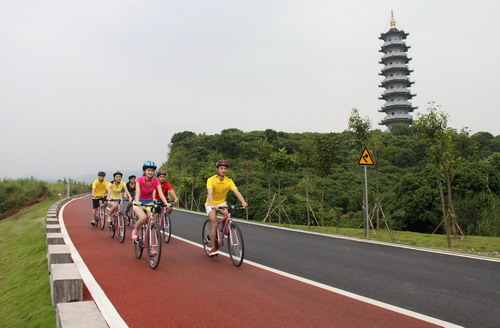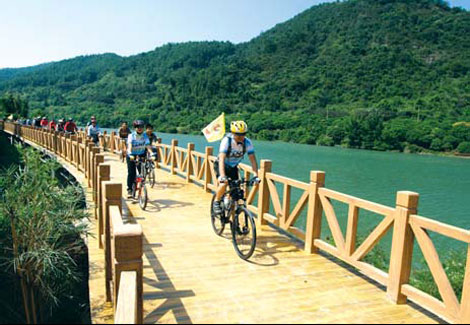Conghua banking on its waterways and greenbelts
Updated: 2011-08-03 07:50
By Guang Ji (China Daily)
|
|||||||||||
|
Conghua has a 187-km-long greenbelt for improved rural tourism. Provided to China Daily |
One county-level, environmentally friendly city in Guangdong province has been expanding its greenbelt network to improve leisure tours in a three-dimensional way - by road, river and air - the mayor reported recently.
The city of Conghua, in Guangzhou, built 187 km of these greenbelts with six post houses and 15 service centers last year. They included a 109-km strip along picturesque Liuxi River, linked to 50 scenic spots. This is just one section of a 2,372 km greenway Guangdong built last year, Mayor Guo Qinghe explained.
A greenbelt is a long, narrow strip of land planted in shrubs and trees to improve the environment and possibly provide recreational space. The United States has as many as 1,000 greenbelts across 23 major cities and a larger number of townships.
Conghua began an 11-km greenbelt project last year by banking on its waterways, especially the Liuxi River. The project will integrate the greenbelt with rural tourist sites and other resources near Guangzhou's equestrian racecourse.
The first 6.3-km section of the watery greenway, scheduled for completion later this month, will handle four sightseeing boats, each with a 30-person capacity, said Li Miaojuan, director of the city's tourism office.
As for the airborne part, Conghua held an international aviation education fair for young people at the end of last month for starters. It invited 60 young people from the United States, Britain, Australia, Italy, the Netherlands and 10 other countries to try their hand at parachuting.
City authorities hope this event marked the beginning of their airborne greenbelt development.
Other outdoor sporty choices include cross-country hikes, camping, and biking to give the city's the tourism sector a boost.
The equestrian site, after a bit of renovation, will be a training and service center for the Hong Kong Jockey Club.
Another greenbelt-themed event - the Conghua photo contest on the same day as the aviation education fair.
 |
| The Wenfeng Tower section of the greenbelt. |
Conghua has been called a Tropic of Cancer oasis and provides a green shield and important water resources for Guangzhou. There are three world-class things it is especially proud of: its hot springs, the equestrian venue built for last year's Asian Games equestrian events, and the world's largest pumped storage hydropower plant.
The Liuxi River national forest park, the Shimen national forest park, and the equestrian site are seen as national wonders.
The city also takes pride in its 68.3-percent forest coverage, 365 days of excellent air quality, and high-quality water standard of the Liuxi River's water.
These things have allowed Conghua to upgrade its facilities overall, for example, the nine five-star hotels that have been built or are planned.
One top resort hotel project, costing about 8 billion yuan ($1.24 billion), will contain the world's largest indoor skiing area, a convention center, and shopping, entertainment, and health facilities.
It will also have nearly 4,700 hotel rooms, and is expected to be South China's largest resort complex.
Conghua has already seen a 21-percent increase in the number of visitors, and a 23.3-percent increase in tourism revenues in the first half of this year, according to Huang Hehong, the city's Party secretary.
Last year, the city had 10.21 million visitors, a 35.2-percent year-on-year increase, and 3.53 billion yuan in tourism revenues, up 37 percent.
Conghua has increased its planning efforts and vastly improved its tourism management and service quality and is selling itself as the most ecologically livable city in the entire Pearl River Delta region, as part of its own 12th five-year plan.
It plans to make the most of its equestrian site and better integrate its agriculture with tourism as a way of bridging the urban-rural development gap.
It is also improving its road network within half an hour's drive of Guangzhou by spending 4 billion yuan every year up through 2015 on infrastructure.
It also intends to deal with pollution by making air and water quality a key part of development.
(China Daily 08/03/2011 page3)
